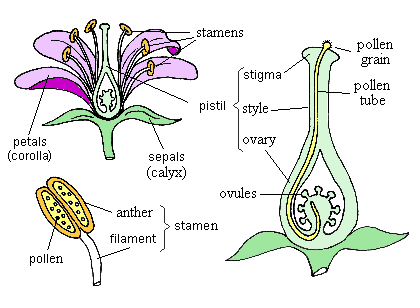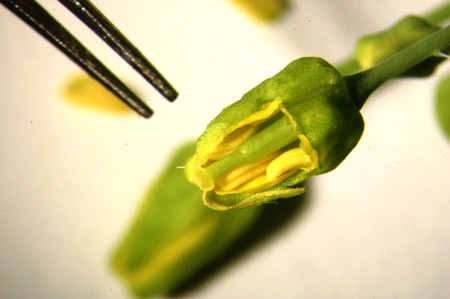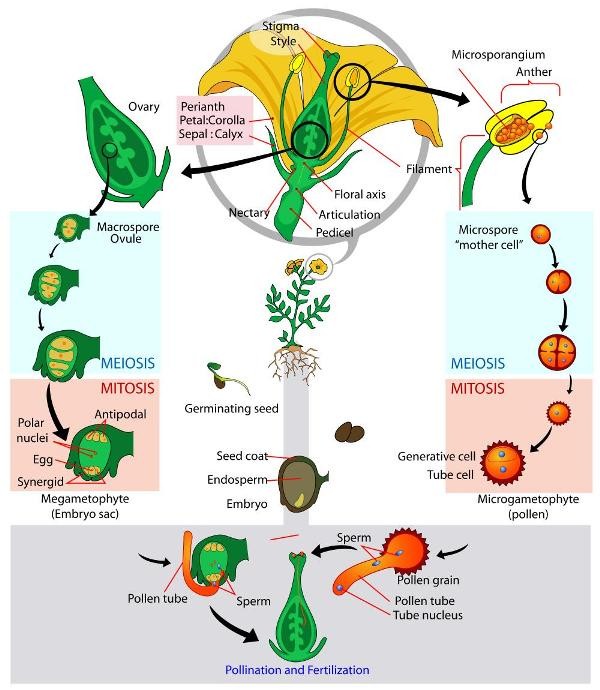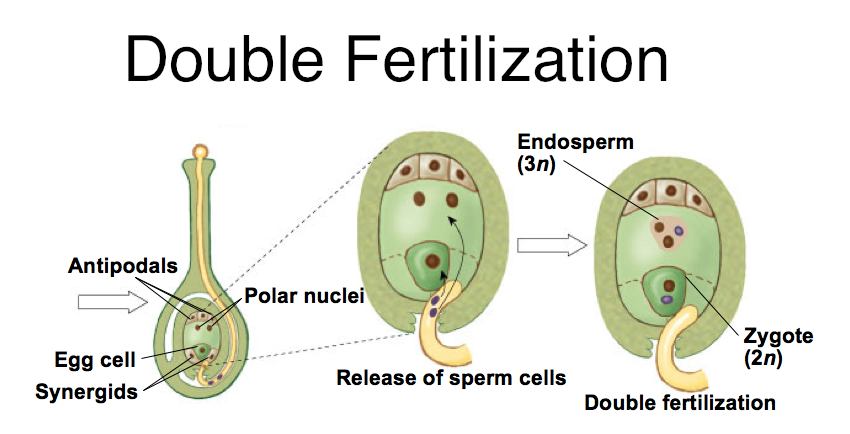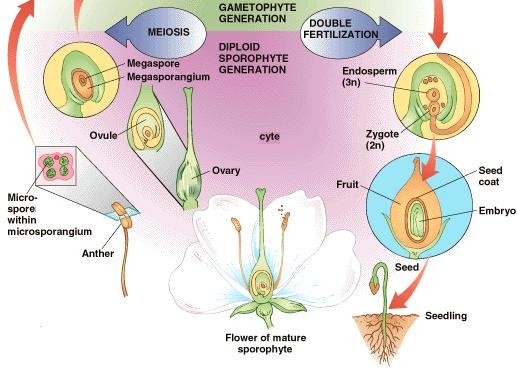Sexual Reproduction in Flowering Plants
Table of Content |
Androecium and Gynoecium are known to be the conceptive structures of a flower.
The male conceptive structure is Androecium. It comprises of whorl of stamens.
Stamen: It has slim stalk known as Filament. At its tip is contained a bilobed structure called anther. Usually these are bilobed anthers containing two theca (dithecous) isolated by longitudinal groove. The transverse section of any anther shows four sided micro sporangia two in every flap. Microsporangia further form the pollen sac. Contained in the pollen sac are the pollen grains.
Structure of Micro Sporangia
Microsporangium is encompassed by 4 layers:
-
Epidermis: external single layer of defensive cells.
-
Endothecium: Endothecium is a single celled layer possessing the character of dehiscence. It discharges pollen dust. The character of dehiscence is because of the hygroscopic nature of endothecium.
-
Middle layers: It is characterized by three to four layers of cells.
-
Tapetum: It is the deepest layer of micro sporangia that provides nourishment to maturing microspores.
 Microsporengiogenesis: It is the procedure of development of microspores from dust mother cells through the process of meiotic cell division. The microspores framed are a group of four cells called Microspore Quadruplicate. As there is further development in the anther the moisture from the anther also dries out. The microspores separate and form into dust grains.
Microsporengiogenesis: It is the procedure of development of microspores from dust mother cells through the process of meiotic cell division. The microspores framed are a group of four cells called Microspore Quadruplicate. As there is further development in the anther the moisture from the anther also dries out. The microspores separate and form into dust grains.
Pollen Grains: Pollen Grains or Dust Grains are round in shape. It consists of two layers: external called Exine and internal called Intine. The exine is comprised of a natural compound sporopollenin. It is hard and resistance natural compound.No one protein is known to debase this protein. The exine consists of a typical pore called germ pore.
As the dust grain develops, it contains two cells: a greater Vegetative Cell and minute Generative Cell. The generative cell isolates mitotically into two male gametes.
Gynoecium
The female regenerative part of the flower is the Gynoecium. It comprises of pistil. Gynoecium is termed in many ways:
-
Monocarpellary : Gynoecium comprises of single pistil. For Example: Pea, Bean.
-
Multicarpellary: Gynoecium comprises of more than one pistil.
-
Syncarpous: Gynoecium with combined pistil. For Example: Tomato, Cucumber.
-
Apocarpous: Gynoecium with free pistil. For Example: Lotus Vinca.
-
Pistil: Each pistil has three sections - the Stigma, Style and Ovary.
• Stigma: At the tip of pistil is the stigma that provides a landing stage for dust grains.
• Style: The style is the lengthened slender part underneath the stigma.
• Ovary: The basal lump part of the pistil is ovary.
The hole inside the ovary is called Ovarian Hole (Locule). The Megasporangia usually called Ovule emerge from the placenta. The quantity of ovules inside an ovary might be one (mango, paddy, wheat) or numerous (orchids, watermelon, papaya).
Gynoecium diagram in a flower
Gynoecium diagram
Megasporangium (Ovule): The ovule is a minute structure connected to the placenta with a stalk known as Funicle. The ovule's body wires with funicle in the area called Hilum.
Each ovule has maybe a couple of defensive envelopes called integuments. Integuments encompass the ovule aside from at the tip. The minute opening at the tip is called Micropyle. Chalaza is a structure present opposite to the micropylar end. It denotes the basal part of the ovule. (explained in the diagram of embryo sac presented below)
The integument encloses nucellus which is a mass of cells. These cells have abundant nourishment materials. Inside the nucleus is the embryo sac or female gametophyte. An ovule by and large has a single embryo sac shaped from a megaspore through reduction division.
Megasporogenesis
The procedure of arrangement of megaspores from the megaspore mother cell is known as Megasporogenesis. Ovules for the most part separate a single Megaspore Mother Cell (MMC) in the micropylar area of the nucellus. The MMC experiences meiotic division.
The dominant part of flowering plants, one of the megaspores is utilitarian while the other three deteriorate. This functional megaspore forms into the female gametophyte.
(Note - The nucellus is by nature diploid. MMC is diploid; the utilitarian haploid, female gametophyte is haploid.)
The core of the utilitarian megaspore divides mitotically to shape two nuclei. These two move to the inverse shafts, forming the 2-nucleate embryo sac. Two more successive mitotic atomic divisions result in the arrangement of 8-nucleate phases of the embryo sac.
One nucleus from every shaft comes to centre of embryo sac. They intertwine to frame secondary nucleus. The three nuclei at the chalazal end shapethe antipodal.
The three nuclei at the micropylar end sort out in to egg apparatus. They are recognized in to two Synergids with an egg between them. The angiosperm embryo sac, at development, however 8 nucleate but is 7-celled.
Pollination
Transfer of dust grains to the stigma of a pistil is called Pollination.
Type of Pollination
• Autogamy: Transfer of dust grains from the anther to the stigma of a similar flower is called autogamy. In such flower anthers and the stigma lie near each other with the goal that self-pollination can happen.
Chasmogamous flowers and Cleistogamous flowers: Some plants produce two sorts of flowers. For Example: Viola (Regular Pansy), Oxalis, and Commelina. Flowers with uncovered anthers and stigma are known to be chasmogamous flower. Flowers which don't open are known as Cleistogamous Flowers.
• Geitonogamy: Transfer of dust grains from the anther to the stigma of the diverse flower but of the similar plant is called Geotonogamy. Hereditarily it is like autogamy on the grounds that the dust grains originate from the same plant.
• Xenogamy: Transfer of dust grains from anther to the stigma of an alternate plant but of the same species.
Agents of Pollination: Plants utilize two abiotic (Wind and Water) and one biotic (Animals) operators to accomplish pollination. Majority of plants utilize biotic operators for pollination. Just a little extent of plants utilizes abiotic operators.
• Anemophily: The pollination happened by the impact of wind as an operator is called Anemophily.
• Hydrophily: The pollination happened by the impact of water as an operator in hydrophytes is called Hydrophily.
• Zoophily: The pollination happened by the impact of creatures as an operator is called Zoophily.
On the basis of various sorts of creatures involved in pollination, they are grouped into:
• Entamophily: The pollination happened by the impact of insects as an operator is called Entamophily.
• Ornithophily: The pollination happened by the impact of birds as a specialist is called Ornithophily.
•Chirapterophily: The pollination happened by the impact of bats as a specialist is called Chirapterophily.
-
Anemophily: It is the name given to the pollination by wind. Little flowers are pollinated by anemophily. These plants produce huge measure of dust grains. For Example: Sugar Stick, Grasses, Bamboo, Rice, and so on. The anemophilous flowers are small and never shaded in bright color. They are unscented and never create nectar. Pollen grains are little, dry and light. Stigmas are bushy and spread to trap dust grains floating in air.
-
Hydrophily: It is the pollination by water. Not all aquatic plants experiences hydrophily. When the pollination happens underneath the water level it is called Hypohydrogamic. It found in plants like Hydrilla, Ceratophyllum. When the pollination happens at the water level is called Epihydrogamic. It is found in plants like Vallisneria.
In some other aquatic plants like water hyacinth (Eichhornia), water lily flower develops out of water and pollination happens by wind or insects. In vallisneria, the sub-consolidated aquatic plant, the male flowers opens at the surface of water. The discharged dust grains coasts on water flow. The pedicel of female flower stretches till it achieves the water surface to contact with dust grains.
• Zoophily: It is the pollination by creatures like bats, birds, insects, wasps, honey bees and so on. Majority of plants are pollinated by insects.The entamophilous flowers have some trademark highlights:
-
The flowers are fragrant and overlook scent. For Example: Jasmine, Rose.
-
The flowers are colorful to attracted insects.
-
The nectar organ produces nectar to encourage visiting insects.
-
The dust grains are sticky or spiny. It attaches to the group of visiting insects.
-
To catch dust grains, the stigma has to be sticky.
Yucca plant is pollinated by moth. The moth and yucca can't finish their existence without each other. The moth drills an opening in ovary to lay its eggs. At that point it gathers dust grains from a few flowers and pushes in the honor end of stigma. After fertilization and seed improvement, the hatchlings of moth eat developing seeds. The unconsumed seeds are scattered to spread. Accordingly, moth can't sustain life without moth and yucca can't imitate sexually without moth.
Inbreeding: The fertilization that happens within the single plant is called inbreeding. Larger part of plants is androgynous. The autogamy (self fertilization) and geitonogamy brings about inbreeding. The significant disadvantage of self fertilization is, the offspring gets feeble and causes diminished wellness in population. It is called inbreeding wretchedness. To stay away from these, plants create numerous structures that demoralize self fertilization.
Outbreeding: The fertilization happens between two unique plants of same species is called out breeding. The Xenogamy (cross-pollination) brings about outbreeding. The plants accomplished out-breeding by numerous systems. The Unisexual Flowers are delivered in same plant or distinctive plant. In monoecious plants with unisexual flowers, similar to castor, cucurbita, maize it maintains a strategic distance from autogamy. In diecious plants like papaya, mulberry, it brings about xenogamy.
Self-Sterility or Incompatibility: In this dust of the flower has no fertilizing impact on stigma of a similar flower. For Example: Passiflora, Potato.
Dichogamy: In this male and female sex organ develops at various times. Ex: china rose, lady's finger, jasmine, Custard apple.
Herkogamy: The anther and stigma are put at various positions so that pollens are not able to achieve stigma of same flower.
Artificial Hybridization
Pollinating the dust grains of one flower to the next flower of various plants of same species is known as Artificial Hybridization. It is one of the significant approaches of harvest improvement program. In this strategy, the required dust grains are utilized for pollination. The stigma is shielded from contamination with other dust grains. It is accomplished by castration and bagging.
Emasculation: It is the expulsion of anthers/stamens from flower bud before it develops.
Emasculation diagram
Bagging: It is the covering of undermined flower with margarine paper to avert contamination with different pollens.
Different methods of Bagging
Pollen Pistil Interaction: It is the capacity of pistil to perceive the pollen of same species. It experience post pollination occasion that prompts to fertilization. If wrong pollen grain (different species) is arrived on stigma, pistil rejects by preventing dust germination. The acknowledgment and dismissal is interceded by the compound part of dust grain interacting with pistil.
Pollination and Fertilization
Fertilization
The fertilization in angiosperms is named as Double Fertilization and Triple Fusion. As the pollen-grain develops as a rule it contains One Vegetative Cell and Two Generative Cells that form into male gamete. In a few plants dust grain sheds as two cell condition. In this, generative cell partitions into two male gametes as pollen tube shapes.
As the dust grain arrives on stigma, it begins to germinate. The pollen tube create leaves germ pore. It develops through the tissue of stigma, style and infiltrates the ovule.
The section of pollen tube in to ovule is from a distinct place and is distinguished into:
1. Porogamy: It is the passage of dust tube through micropyle.
2. Chalazogamy: It is the passage of dust tube through chalaza.
3. Misogamy: It is the section of dust tube through integument or funicle.
As pollen tube enters the ovule, the tip breaks inside the embryo sac leading to the release of two male gametes.
One of the male gamete wires with egg and structures diploid zygote. Another male gamete wires with diploid secondary nucleus to frame triploid endosperm.
The fusion of two polar nuclei (to frame secondary diploid nucleus) and male gamete is named as Triple Fusion. The two fusions as zygote development and triple fusion is named as Double Fertilization.
Post-fertilization stages
It is the series of occasions that happens after double fertilization. It includes:
1. Endosperm development.
2. Embryo improvement.
3. Development of ovule into seed.
4. Development of ovary into fruit.
1. Endosperm: The endosperm cell, shaped by triple fusion under goes rehashed mitotic cell division to frame triploid endosperm tissue. It gives sustenance to the developing embryo. Three unique sorts of endosperms are accounted as follows:
Nuclear endosperm: In this endosperm cell nucleus experiences free nuclear division. Every one of these nuclei is pushed to the fringe forming central vacuole. The cytokines is brings about the development of endosperm tissue. Example: coconut. The vacuole is loaded with liquid.
Cellular endosperm: In this endosperm cellular division experiences cytokinesis. Example: Datura.
Helobial endosperm: In first endosperm cell division two unequal cells shapes. One cell experiences cellular division and other under go free nuclear division. Example: monocots. In pea, groundnut, beans endosperm is totally devoured by developing embryo. In a few seeds like groundnut, castor endosperm perseveres developed seeds.
2. Embryo improvement: (refer to pollination and fertilization diagram above)
In Dicot: The zygote separates transversely in to upper suspensor cell exhibited at micropyle area and lower embryonal cell exhibited at chalazal district. The suspensor cell partitions and structures 7 – 10 cells called suspensor. The upper cell of suspensor extends and appends to the embryo sac. The embryonal cell separates into eight cells. The lower four cells creates in to form one plumule and two cotyledons. The above four cells close to the suspensor creates in to form hypocotyl and radicle. The completely created embryo of dicotyledons has an embryonal hub that separated into plumule, two cotyledons and a radicle. The lower end of radicle (root tip) is secured with root cap. In the starting embryo is globular in shape. At the point when two cotyledons separate it frames heart shape.
In monocots: The zygote isolates transversely in to upper suspensor cell display at micropyle locale and lower embryonal cell exhibited at chalazal district. The embryonal cell partitions into globular embryo. It frames a huge cotyledon and plumule. Plumule is covered by coleoptile. The single cotyledon is called scutellum. At lower end of embryonal pivot radicle creates. It is secured by a sheath called coleorhiza.
3. Seed: (refer to pollination and fertilization diagram above) The final result of sexual reproduction is the formation of seed. It is the ovule that is fertilized. Seed comprises of seed coat, cotyledon and embryonal hub. The cotyledons are swollen because of their capacity of hold sustenance. The seeds are either albuminous or non-albuminous. In albuminous seed endosperm is not totally utilized by embryo. Example: wheat, maize, castor, sunflower. In a few seeds like dark pepper the nucellus is additionally present. The leftover persistent nucellus is called Perisperm. In non albuminous seed endosperm is totally utilized by embryo. Example: Pea, Groundnut. The seed coat is developed from the integument of ovule. The micropyle remains as a pore in the seed coat. It encourages the section of oxygen and water in to seed during germination. Seeds become scarce by loosing water. The embryo enters dormancy, the phase of inactivity. As the conditions become favorable again it begins germination.
4. Fruit: The wall of ovary forms into organic product wall called pericarp. It encompasses the seed. In apple, strawberry the fruit is developed from the thalamus. Subsequently these are termed false fruit. The fruits created from unfertilized ovary are called Parthenocarpic Fruits. Parthenocarpic fruits are seedless.
Apomixes: Apomixes is the process of formation of seed without the fertilization of ovule and the fruits created from unfertilized ovule are termed apomictic fruits. The descendants of hybrid isolate their characters and not continue the hybrid character till a great many generations. Consequently the ranchers ought to purchase hybrid seeds each year. It makes broad. The apomixes is performed in hybrid plants to maintain a strategic distance from the isolation of characters. The farmers can utilize hybrid seeds to raise new yield each year.
Polyembryony: The nearness of more than one embryo in seed is known as Polyembryony. Example: Seeds of citrus fruits.
Process of Fertilization in plants
Watch this Video for more reference
View courses by askIITians


Design classes One-on-One in your own way with Top IITians/Medical Professionals
Click Here Know More

Complete Self Study Package designed by Industry Leading Experts
Click Here Know More

Live 1-1 coding classes to unleash the Creator in your Child
Click Here Know More


